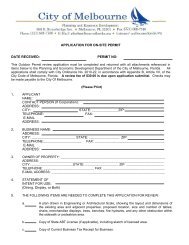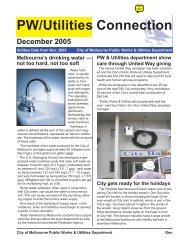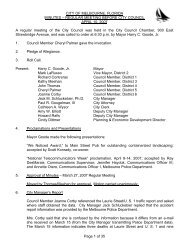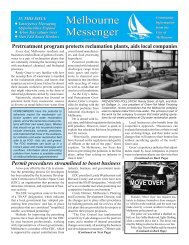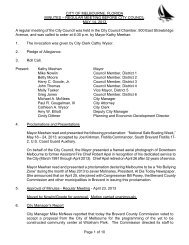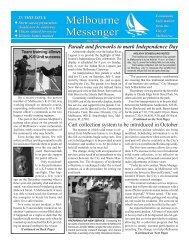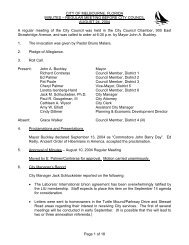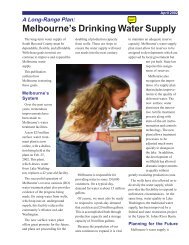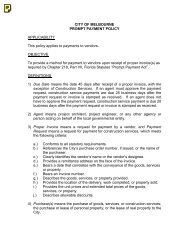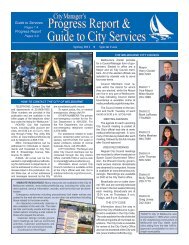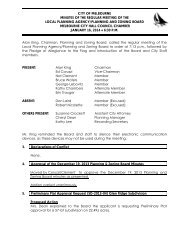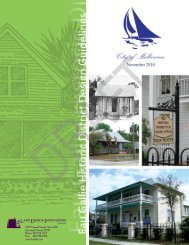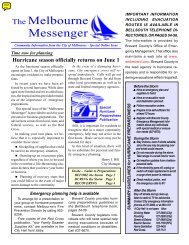March 26 - City of Melbourne, Florida
March 26 - City of Melbourne, Florida
March 26 - City of Melbourne, Florida
Create successful ePaper yourself
Turn your PDF publications into a flip-book with our unique Google optimized e-Paper software.
CITY OF MELBOURNE, FLORIDA<br />
MINUTES – REGULAR MEETING BEFORE CITY COUNCIL<br />
MARCH <strong>26</strong>, 2013<br />
Peter Snyder, Executive Director, <strong>Florida</strong> Turf Grass Association, Lakeland, stated that he<br />
represents sports turf managers, golf course superintendents, lawn care pr<strong>of</strong>essionals, sod<br />
producers, and commercial/institutional groundskeepers. He provided the names <strong>of</strong> some <strong>of</strong><br />
the research they have funded at the University <strong>of</strong> <strong>Florida</strong>, including “The Putting Speed <strong>of</strong><br />
Paspalum,” and stressed that they have not funded one study on nutrient research.<br />
Mr. Snyder stated that he is here to advocate on behalf <strong>of</strong> healthy turf grass because science<br />
clearly shows that healthy turf grass provides the best filter <strong>of</strong> nutrients. It also cools the<br />
environment, improves carbon sequestration, provides recreational benefits, etc. Science<br />
clearly shows that more restrictive provisions, such as summer blackouts, will have<br />
unintended consequences <strong>of</strong> creating more nutrient leaching into water bodies. He stated<br />
that they are an extremely heavily regulated industry and provided examples. Mr. Snyder<br />
encouraged Council to pass the model that was developed by a consortium <strong>of</strong> very bright<br />
people.<br />
Mr. Jones asked what criteria the industry uses to judge good science. Mr. Snyder replied<br />
that they rely on peer review studies and reputable journals. He added that the eight-year<br />
study that came out <strong>of</strong> IFAS is spectacular science.<br />
Mr. Jones asked how the industry has adapted to more stringent guidelines in the Sarasota<br />
and Tampa area. Mr. Snyder replied that some people have packed up and left while others<br />
have raised their (rates). There have been lay<strong>of</strong>fs because <strong>of</strong> the four-month blackout<br />
period.<br />
Mr. Jones asked what the industry’s approach is to phosphorus. Mr. Snyder replied that<br />
from his point <strong>of</strong> view, a soil analysis is required. Phosphorus should be used only when it’s<br />
needed.<br />
Mr. Snyder confirmed for Council Member Jones that a soil test costs about $10. He added<br />
that it’s only done when it appears there is a deficiency.<br />
Mr. Jones asked Mr. Snyder if his industry is committed to spending money to educate<br />
citizens, not just people in the industry. Mr. Snyder replied absolutely and elaborated.<br />
Vice Mayor Tasker asked Mr. Snyder if he would object to specific wording about a voluntary<br />
fertilizer free zone <strong>of</strong> 10 feet on each side <strong>of</strong> streets without stormwater retention that drain<br />
into the Indian River Lagoon. Mr. Snyder said that he could personally support voluntary,<br />
with education.<br />
Mrs. Tasker returned to the phosphorus language, where it states only no phosphorus or low<br />
phosphorus as defined in a specific <strong>Florida</strong> Administrative Code. She said that no<br />
phosphate is defined as products with a level below .5%. Low phosphate fertilizer means<br />
products with levels equal to or above .5%. She stated that this is vague and has no<br />
meaning. Anything above .5% could mean 97%; therefore, it’s legally insufficient.<br />
Page 14 <strong>of</strong> <strong>26</strong>



